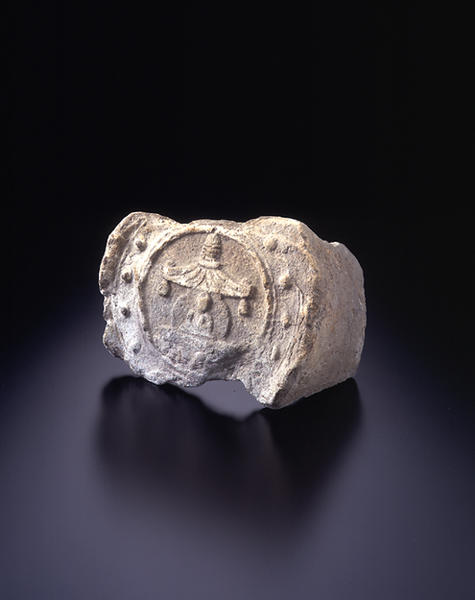宝塔文軒丸瓦
- 平安時代
- 12c
- 瓦陶製
- H-12.9 D-12
解説(春の玉手箱)
宝塔と如来の文様を表した、軒丸瓦の断片である。塔は屋根上に宝珠、九輪、請花を備え、屋根には瓦を表して軒に風鐸を付け、首部の下には円形に近い軸部と方形の基壇を置く。塔の周囲には二重の円を巡らし、間を連珠文で装飾している。
軒丸瓦の文様は、飛鳥・白鳳時代は主として蓮華文が多かったが、平安時代になると、巴文、五輪塔、輪宝、文字などが用いられるようになる。宝塔文の瓦は、法勝寺跡や鳥羽離宮跡を初め、大阪からも出土例があるが、本作品はそのどれとも異なっている。宝塔の開口部を表現してはおらず、その分、如来がゆったりと表現されている。法華経に宝塔如来が地から湧出する話があり、法華経は書写の功徳を説いている事もあって、この頃盛んに装飾経が造られたが、瓦にまでもその意匠が取り入れられたのであろうか。仏の道に憧れる当時の人々と、そこに漂う美観の匂い立つような作品である。
Catalogue Entry
This is a fragment of a round roof tile with images of a jewel pagoda and a Buddha. This pagoda is topped with a jewel shape, nine rings, floral design and its roofs would be tiled with wind bells set at each eaves point. The area beneath the roof is circular and set on a square base. The pagoda is surrounded by a double circle and linked jewel patterns decorate the space between these circles.
While many of the Asuka and Hakuho period round roof tiles were decorated with lotus patterns, with the beginning of the Heian period, these patterns diversified to include tomoe jewel patterns, five‐story pagodas, round jewels, and lettering. Excavated examples of tiles with jewel pagoda designs were found at the Hoshoji ruins, Toba palace ruins, and in Osaka, and yet, each of these examples different from the Miho tile. Here, instead of showing the open doors of the pagoda, a Buddha image is displayed in full repose.
The Lotus Sutra tells the tale of a jewel pagoda and Buddha rising from the earth and since great merit was earned for copying out the Lotus Sutra, the Heian period witnessed the creation of many beautifully decorated sutra copies. The sutra's motifs extended to use even on roof tiles.
This work seems to emanate a sense of these people devoutly setting out on the path of Buddhism during the Heian period.
